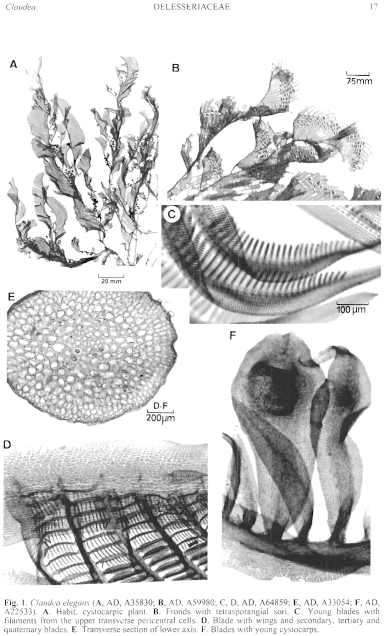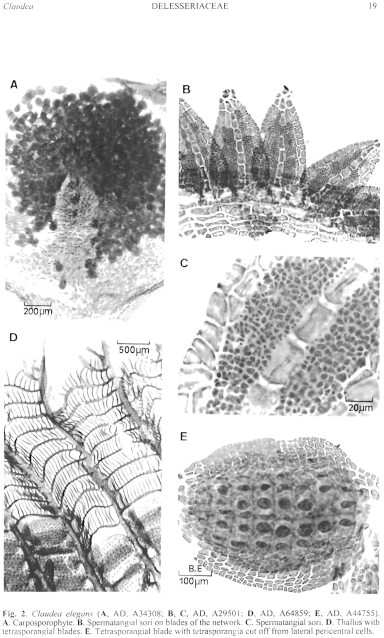|
|
|
|
|
|||||||||||
|
Electronic Flora of South Australia Species Fact Sheet
Phylum Rhodophyta – Family Delesseriaceae
Selected citations: J. Agardh 1863: 1275; 1879: pl. 32 figs 30–33. De Toni 1900: 748. Guiler 1952: 100. Harvey 1844a: 408, pl. xx; 1844b: 430; 1846: 378; 1847: 15; 1855a: 537; 1858: pl. 1; 1859b: 294. 1863, synop.: xiv. Hooker & Harvey 1847: 307. Huisman 1997: 200. Kützing 1843: 451; 1849: 888; 1869: 21, pl. 55. Kylin 1956: 437, figs 329B–D, 348C. Lucas 1909: 37; 1929a: 20. Lucas & Perrin 1947: 237, fig. 101. May 1965: 395. Mazza 1908: No. 257. Norris 1987a: 311, figs 1–6. Oliveira 1977: 118. Schmitz & Hauptfleisch 1897: 416. Shepherd & Womersley 1981: 366. Silva et al. 1996: 453. Sonder 1853: 696; 1880: 30. Wilson 1892: 164. Womersley 1950: 183. Wynne 1983: 443; 1996: 179; 1998: 40.
Synonyms
Lamourouxia elegans C. Agardh 1817: xiv.
Oneillia elegans (Lamouroux) C. Agardh 1822: 170; 1824: 253.
Fucus claudei Turner 1819: 108, pl. 243, nom. illegit.
Thallus (Fig. 1A, B) rose-red to grey-red, (10–) 20–40 cm high, with several axes usually basally branched and becoming 2–3 mm thick basally. Axes with upper net-like fronds (Fig. B) usually 5–15 cm long and 1–3 cm broad, tapering apically, unilaterally placed on narrow "mid-ribs" with membranous wings opposite the nets and rectangular interstices (Fig. 1D); apices of fronds usually curved abaxially, with frond margins dentate (Fig. 1B) due to the apices of second-order filaments; axes becoming thickened (Fig. 1E) and denuded below. Holdfast discoid, formed of spreading rhizoids, becoming pseudoparenchymatous; epilithic or on shells. Structure. Apical cells of blades dome-shaped, segmenting after 4–7 cells to form first 2 lateral pericentral cells, followed by lower (abaxial) and upper (adaxial) transverse pericentral cells. The lateral pericentral cells cut off 2 flanking cells, the upper (anterior) one forming a second-order row with most of the inner cells forming third-order rows; the lower (posterior) flanking cell develops as an unbranched third-order row also. Short fourth-order rows may develop from cells near the margin, and all rows reach the thallus margin. The wings developed from the lateral pericentral cells become 1–2 mm and many cells broad on the primary axes (Fig. 1D). The upper (adaxial) transverse pericentral cells produce secondary blades from successive segments, branched as above but smaller, lying in a plane at right angles to the parent blade, 80–120 µm and 6–10 cells broad. These secondary blades produce filaments (Fig. 1C) (4–) 6–10 cells long from the upper transverse pericentral cells which extend to and unite with the lower (abaxial) transverse pericentral cells of the secondary blade above them. As the frond expands, these filaments develop into tertiary blades (with their apical cell adherent above) which repeat the blade development (Fig. ID). Apices of the secondary blades project as the dentations on the frond margins (Fig. 1B). Cortication of the midrib and lateral cells of primary blades commences some distance below the apices and becomes relatively thick below as the wings and blades are lost from older parts. Cells mostly multinucleate; rhodoplasts discoid.
Reproduction: Gametophytes dioecious. Procarps borne in series (Fig. 6A) on the lower (abaxial) side of primary and secondary blades close to apices, without development of the next order of branches near the procarps. The abaxial pericentral cell becomes the supporting cell, cutting off two sterile groups and a 4-celled carpogonial branch (Fig. 6B). Carposporophyte with a basal fusion cell, much branched gonimoblast (Fig. 2A) with broadly clavate to ovoid terminal carposporangia 50–90 µm in diameter, replaced from subterminal cells. Cystocarps (Fig. IF) on slender stalks 2–5 mm long, single or in small clusters of adjacent stalks developed from the midrib and narrow wings, ovoid, 1–2 mm in diameter, with a slight neck only. Pericarp with an outer cortical layer of irregular but closely adjacent cells. Spermatangial sori (Fig. 2B) covering tertiary and quaternary blades of the nets, derived from lateral pericentral cells and inner cells of second and third-order rows, leaving the transverse pericentral cells and marginal (often also submarginal) cells sterile (Fig. 2C), with the primary cells dividing anticlinally and cutting off initials which each produce several spermatangia.
Tetrasporangial stichidia (Fig. 2D, E) developed from tertiary branches of the nets (which then lack further branches); the lateral pericentral cells form only a single second-order row of elongate cells, apart from division into 2 flanking cells (and later more third-order rows) at the margins. Stichidia ovate, 1–1.5 mm long and 500–700 µm broad, with the tetrasporangia cut off from 3–5 cells of the single rows from the lateral pericentral cells, essentially in a single layer (Fig. 2E) but usually pushed into 2 layers, with occasional further tetrasporangia cut off from the primary cells; the oldest tetrasporangia are situated centrally in the sorus (both longitudinally and near the midrib) and are subspherical, 50–120 µm in diameter.
Type from "Nouv. Holl." (Peron) – locality uncertain; holotype in Herb. Lamouroux, CN.
Selected specimens: Hopetoun, W. Aust., 3–4 m deep (Kraft 7006 & Ricker, 16.viii.1979; MELU and AD, A50714). Nuyts Reef, S. Aust., 28–30 m deep (Shepherd, 26.iii.1980; AD, A52320). Ward I., S. Aust., 18–23 m deep (Shepherd, 3.iii.1980; AD, A50901). Elliston, S. Aust., 7 m deep in bay (Shepherd, 21.x.1970; AD, A37357). Hopkins I., S. Aust., 33 m deep (Branden, 8.i.1989; AD, A59980). Tapley Shoal (Edithburg), S. Aust., 18 m deep (Shepherd, 2.ii.1969; AD, A33447). Off Troubridge Light, Gulf St Vincent, S. Aust., 17 m deep (Shepherd, 4.ii.1969; AD, A33415-"Marine Algae of southern Australia" No. 109). Investigator Strait, S. Aust., 31 m deep (Watson, 23.i.1971; AD, A41094). Bay of Shoals, Kangaroo I., S. Aust., 3 m deep in channel (Womersley, 5.i.1990; AD, A60121). Snapper Point, Penneshaw, Kangaroo I., S. Aust., 20 m deep (Lavers, 24.iii.1996; AD, A64859). Pennington Bay, Kangaroo I., S. Aust., drift (Womersley, 4.i.1948; AD, A6567). Hastings, Western Port, Vic., 20 m deep (Plant, 18.v.1959; AD, A22533). Crawfish Rock, Westernport Bay, Vic., 6–8 m deep (Watson, 10.xi.1968; AD, A33054), 7 m deep (Watson, 5.iv.1970; AD, A35830), 3–4 m deep (Watson & Womersley, 26.iv.1964; AD, A34308) and 4 m deep (Watson & Womersley, 16.i.1974; AD, A44755). Walkerville, Vic., drift (Sinkora A2037, 20.ii.1975; MEL and AD, A48340). West Point, Erith I., Bass Strait, 28 m deep (Shepherd & Lewis, 10.v.1974; AD, A45116). Currie R., Tas. (Perrin, Nov. 1938; AD, A29501).
Distribution: Fremantle, W. Aust., to Walkerville, Vic., and N Tasmania. India, Pakistan, Natal and Brazil (Oliveira 1977, p. 118).
Taxonomic notes: Claudea elegans has been recorded from India and Pakistan (see Silva et al. 1996, p. 453) and from Natal by Norris (1987a, p. 311); the latter specimen has a thick, possibly perennial, lower axis, much thicker than seen in Australian specimens.
References:
AGARDH, C.A. (1817). Synopsis Algarum Scandinaviae. (Berling: Lund.)
AGARDH, C.A. (1822). Species Algarum. Vol. 1, Pt 2, pp. 169–398. (Berling: Lund.)
AGARDH, C.A. (1824). Systema Algarum. (Berling: Lund.)
AGARDH, J.G. (1863). Species Genera et Ordines Algarum. Vol. 2, Part 3, pp. 787–1291. (Gleerup: Lund.)
AGARDH, J.G. (1879). Florideernes morphologi. K. Svenska Vetensk. Akad. Handl. 15(6), 1–199, Plates 1–33.
DE TONI, G.B. (1900). Sylloge Algarum omnium hucusque Cognitarum. Vol. 4. Florideae. Sect. 2. pp. 387–776. (Padua.)
GUILER, E.R. (1952). The marine algae of Tasmania. Checklist with localities. Pap. Proc. R. Soc. Tasmania 86, 71–106.
HARVEY, W.H. (1844a). A few remarks on Claudea elegans. Lond. J. Bot. 3, 408–411, Plate xx.
HOOKER, J.D. & HARVEY, W.H. (1847). Algae Tasmanicae. Lond. J. Bot. 6, 397–417.
HUISMAN, J.M. (1997). Marine Benthic Algae of the Houtman Abrolhos Islands, Western Australia. In Wells, F.E. (Ed.) The Marine Flora and Fauna of the Houtman Abrolhos Islands, Western Australia, pp. 177–237. (W. Aust. Museum: Perth.)
KÜTZING, F.T. (1843). Phycologia generalis. (Leipzig.)
KÜTZING, F.T. (1849). Species Algarum. (Leipzig.)
KÜTZING, F.T. (1869). Tabulae Phycologicae. Vol. 19. (Nordhausen.)
KYLIN, H. (1956). Die Gattungen der Rhodophyceen. (Gleerups: Lund.)
LAMOUROUX, J.V.F. (1813). Essai sur les genres de la famille des thalassiophytes non articulées. Ann. Mus. Hist. Nat., Paris 20, 21–47, 115–139, 267–293, Plates 7–13.
LUCAS, A.H.S. & PERRIN, F. (1947). The Seaweeds of South Australia. Part 2. The Red Seaweeds. (Govt Printer: Adelaide.)
LUCAS, A.H.S. (1909). Revised list of the Fucoideae and Florideae of Australia. Proc. Linn. Soc. N.S.W. 34, 9–60.
LUCAS, A.H.S. (1929a). The marine algae of Tasmania. Pap. Proc. R. Soc. Tasm. 1928, 6–27.
MAY, V. (1965). A census and key to the species of Rhodophyceae (red algae) recorded from Australia. Contr. N.S. W. Natl Herb. 3, 349–429.
MAZZA, A. (1908). Saggio di Algologia Oceanica. Nuova Notarisia 19, Nos. 202–261.
NORRIS, R.E. (1987a). Claudea elegans (Delesseriaceae, Rhodophyceae) in Natal, its first record in the western Indian Ocean and Africa. S. Afr. J. Bot. 53, 311–315.
OLIVEIRA FILHO, E.C. de (1977). Algas Marinhas Bentônicas do Brasil. Univ. São Paulo, Instituto de Biociências. [Thesis.]
SCHMITZ, F. & HAUPTFLEISCH, P. (1897). Delesseriaceae. In Engler, A. & Prantl K., Die natürlichen Pflanzenfamilien. T. 1. Abt. 2. Pp. 406–416.
SHEPHERD, S.A. & WOMERSLEY, H.B.S. (1981). The algal and seagrass ecology of Waterloo Bay, South Australia. Aquat. Bot. 11, 305–371.
SILVA, P.C., BASSON, P.W. & MOE, R.L. (1996). Catalogue of the Benthic Marine Algae of the Indian Ocean. (Univ. California Press: Berkeley.)
SONDER, O.W. (1853). Plantae Muellerianae. Algae. Linnaea 25, 657–709.
SONDER, O.W. (1880). In Mueller, F., Fragmenta Phytographiae Australiae. Supplementum ad volumen undecinum: Algae Australianae hactenus cognitae, pp. 1–42, 105–107. (Melbourne.)
TURNER, D. (1819). Fuci sive Plantarum Fucorum Generi a Botanicis Ascriptarum Icones Descriptiones et Historia. Vol. 4, pp. 1–153, Plates 197–258. (London.)
WILSON, J.B. (1892). Catalogue of algae collected at or near Port Phillip Heads and Western Port. Proc. R. Soc. Viet. 4, 157–190.
WOMERSLEY, H.B.S. (1950). The marine algae of Kangaroo Island. III. List of Species 1. Trans. R. Soc. S. Aust. 73, 137–197.
WYNNE, M.J. (1983). The current status of genera in the Delesseriaceae (Rhodophyta). Bot. Marina 26, 437–450.
WYNNE, M.J. (1996). A revised key to genera of the red algal family Delesseriaceae. Nova Hedwigia 112, 171–190.
WYNNE, M.J. (1998). A checklist of benthic marine algae of the tropical and subtropical western Atlantic: first revision. Nova Hedwigia Beih. 116, 1–155.
The Marine Benthic Flora of Southern Australia Part IIID complete list of references.
Publication:
Womersley, H.B.S. (24 February, 2003)
The Marine Benthic Flora of Southern Australia
Rhodophyta. Part IIID. Ceramiales – Delesseriaceae, Sarcomeniaceae, Rhodomelaceae
Reproduced with permission from The Marine Benthic Flora of Southern Australia Part IIID 2003, by H.B.S. Womersley. Australian Biological Resources Study, Canberra. Copyright Commonwealth of Australia.
Illustrations in Womersley Part IIIA, 2003: FIGS 1, 2, 6A, B.

Figure 1 enlarge
Fig. 1. Claudea elegans (A, AD, A35830; B, AD, A59980; C, D, AD, A64859; E, AD, A33054; F, AD, A22533). A. Habit, cystocarpic plant. B. Fronds with tetrasporangial sori. C. Young blades with filaments from the upper transverse pericentral cells. D. Blade with wings and secondary, tertiary and quaternary blades. E. Transverse section of lower axis. F. Blades with young cystocarps.

Figure 2 enlarge
Fig. 2. Claudea elegans (A, AD, A34308; B, C, AD, A29501; D, AD, A64859; E, AD, A44755). A. Carposporophyte. B. Spermatangial sori on blades of the network. C. Spermatangial sori . D. Thallus with tetrasporangial blades. E. Tetrasporangial blade with tetrasporangia cut off from lateral pericentral cells.

Figure 6 enlarge
Fig. 6. A, B. Claudea elegans (AD, A29501). A. Apex of branch with procarps on each segment. B. Two procarps. C, D. Caloglossa leprieurii (AD, A16070). C. Apex showing exogenous branching, lateral pericentral cells and later-formed transverse pericentral cells. D. Apex of a blade with second- and third-order cell rows. (A–D by Ann Shepley.) E. Apoglossum spathulatum (AD, A63805). Procarp.

|
Email Contact: State Herbarium of South Australia |

|